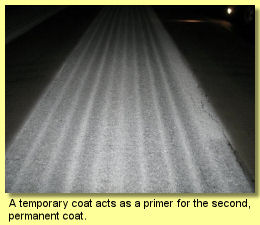 |
 |
It's Only TemporaryBy Donna SpeidelDuring our research a couple weeks back, we were asked our opinion regarding a dilemma among the airport, engineer, and contractor. A new asphalt overlay had just been completed and the finishing elements were being installed, including markings. However, there was discussion about how to properly apply a temporary coating to be followed up by a full coat later in hopes that the first coating would act as a sealant. Here are some instances where temporary striping may be considered. Temporary markings are used in two separate instances:
As a means of changing traffic flow, the markings are often required to be effective for both day and night operations, meaning that a full coat of paint with glass beads is needed. However, if only day operations are required, a light coating of paint without glass beads can be used. If the markings will be removed, the age and condition of the pavement should be considered when specifying the type of material used, and the method of removal.
If the permanent marking is going to be applied within seven days of the first coat, the temporary coating should be at half rate (230 SF/gal) without glass beads (At that coverage rate, the paint film would be too thin to anchor the glass beads). The second coat is later applied at the standard 115 SF/gal (12-16 wet mils) with glass beads. We have seen "permanent" markings end up being "temporary" due to poor application techniques, but that is not usually the intent of the one paying the bill. Our training seminars can fix markings that only last a few months (temporary) to last a lot longer (permanent). Check out this and other services on our cool new website by clicking the "home" button at the top of this page. |

 Temporary markings on new pavements are generally applied immediately after asphalt is installed, permitting traffic on
the surface as soon as possible. However, even when the surface can remain closed for the needed pavement curing time, it is still
advisable to apply a light coating to serve as a primer. These markings will not be removed, but painted over with a full coating of
paint and glass beads. Without the primer coat on new asphalt, the white markings sometimes turn brown until rain finally washes the
oils away.
Temporary markings on new pavements are generally applied immediately after asphalt is installed, permitting traffic on
the surface as soon as possible. However, even when the surface can remain closed for the needed pavement curing time, it is still
advisable to apply a light coating to serve as a primer. These markings will not be removed, but painted over with a full coating of
paint and glass beads. Without the primer coat on new asphalt, the white markings sometimes turn brown until rain finally washes the
oils away.